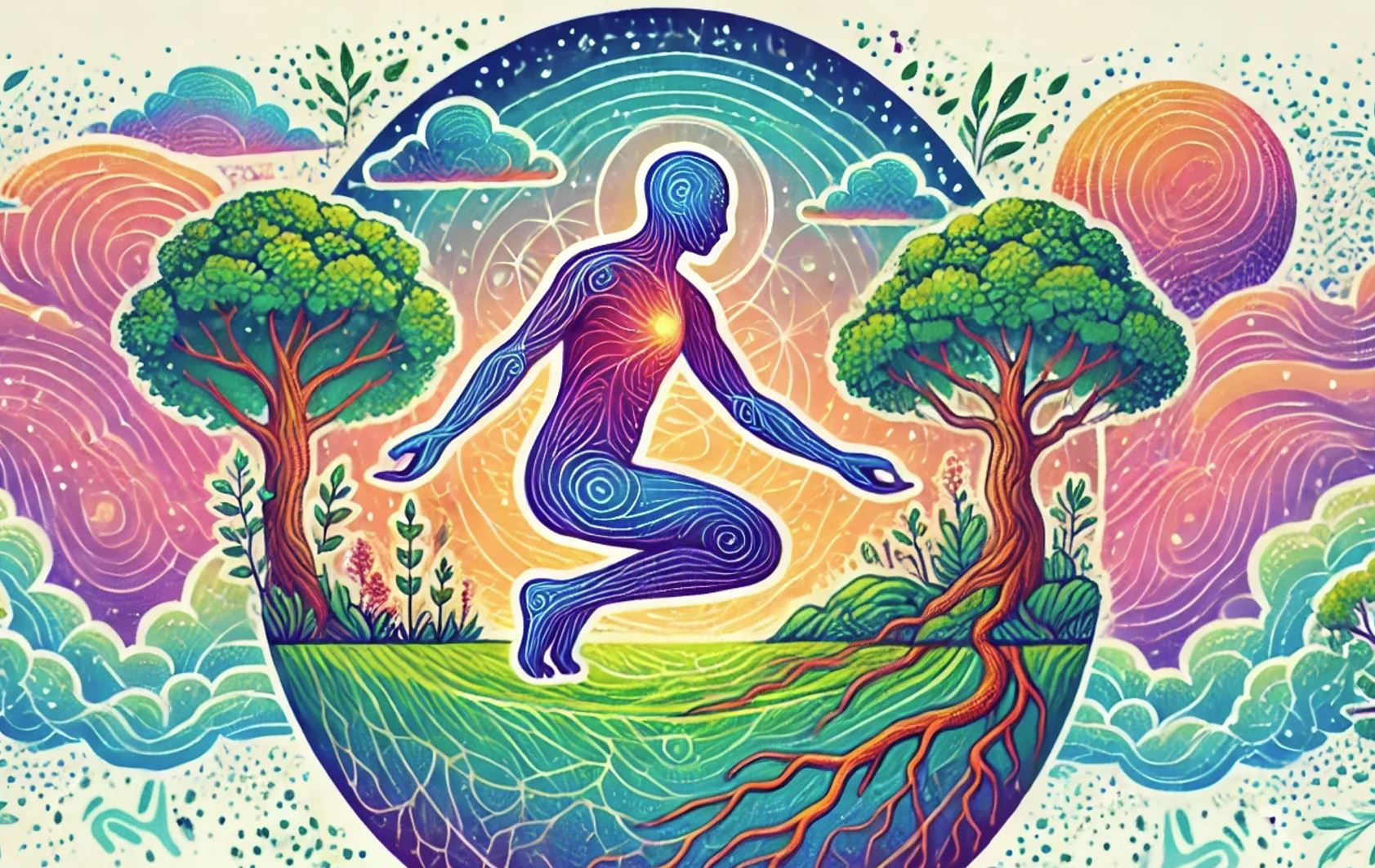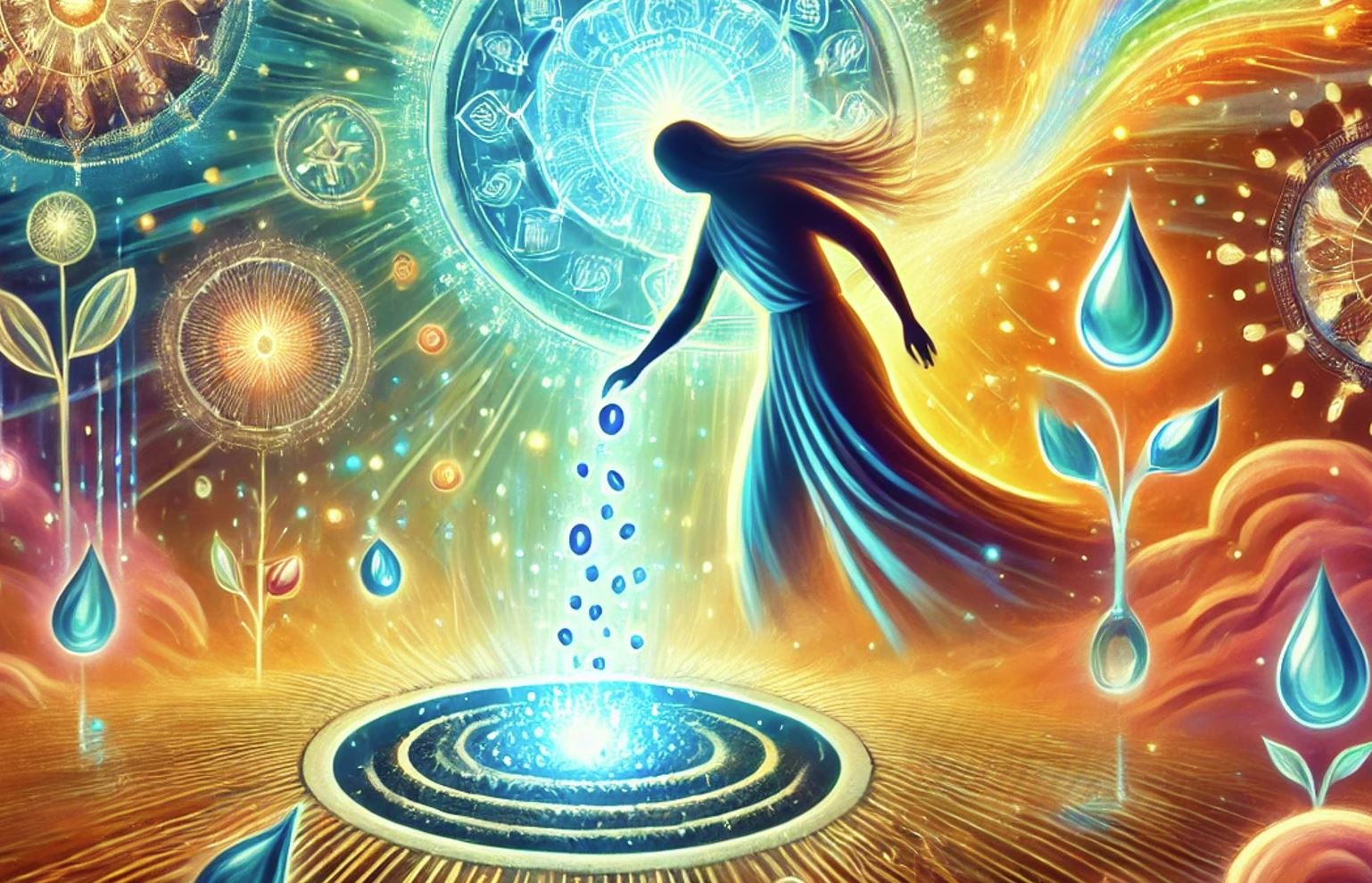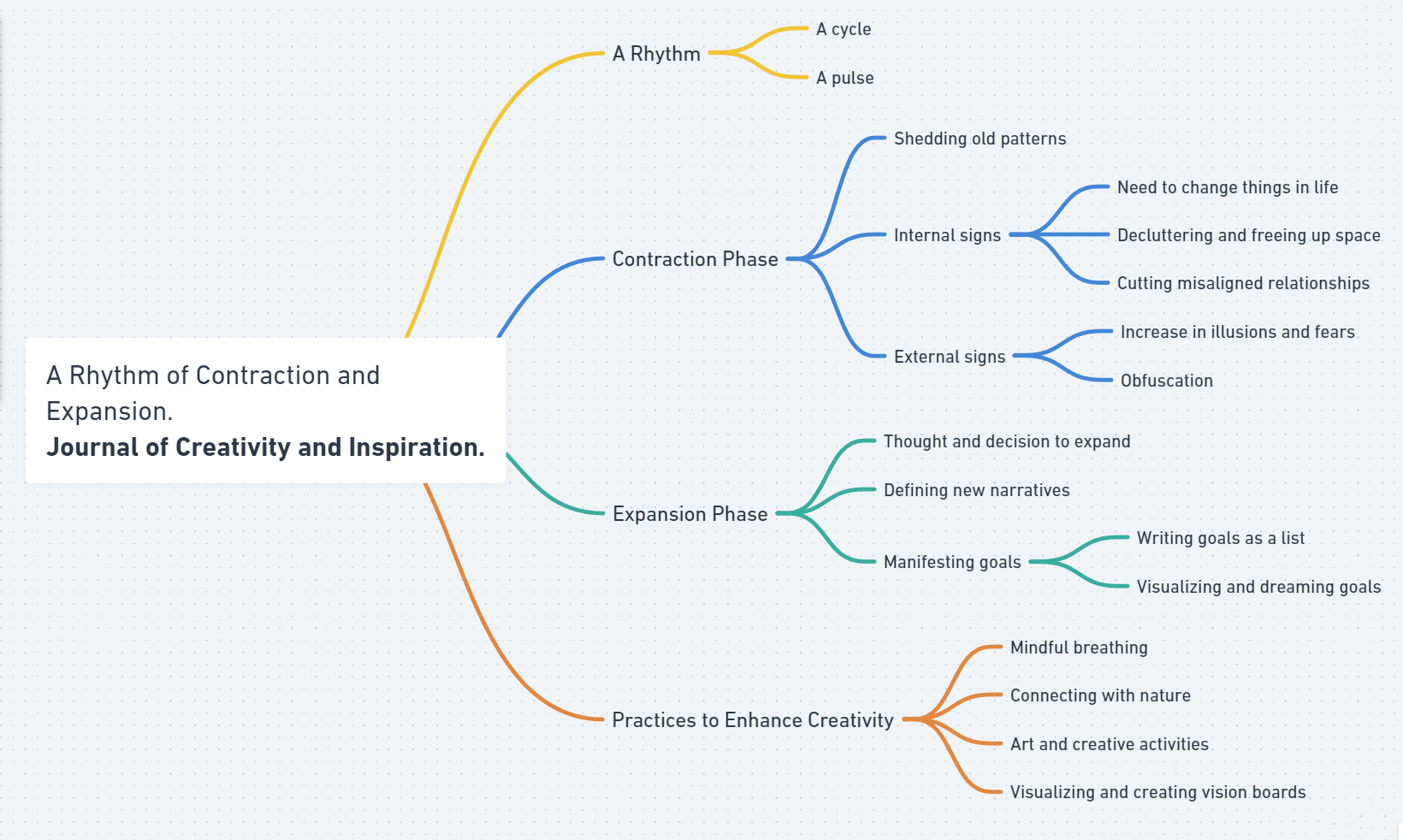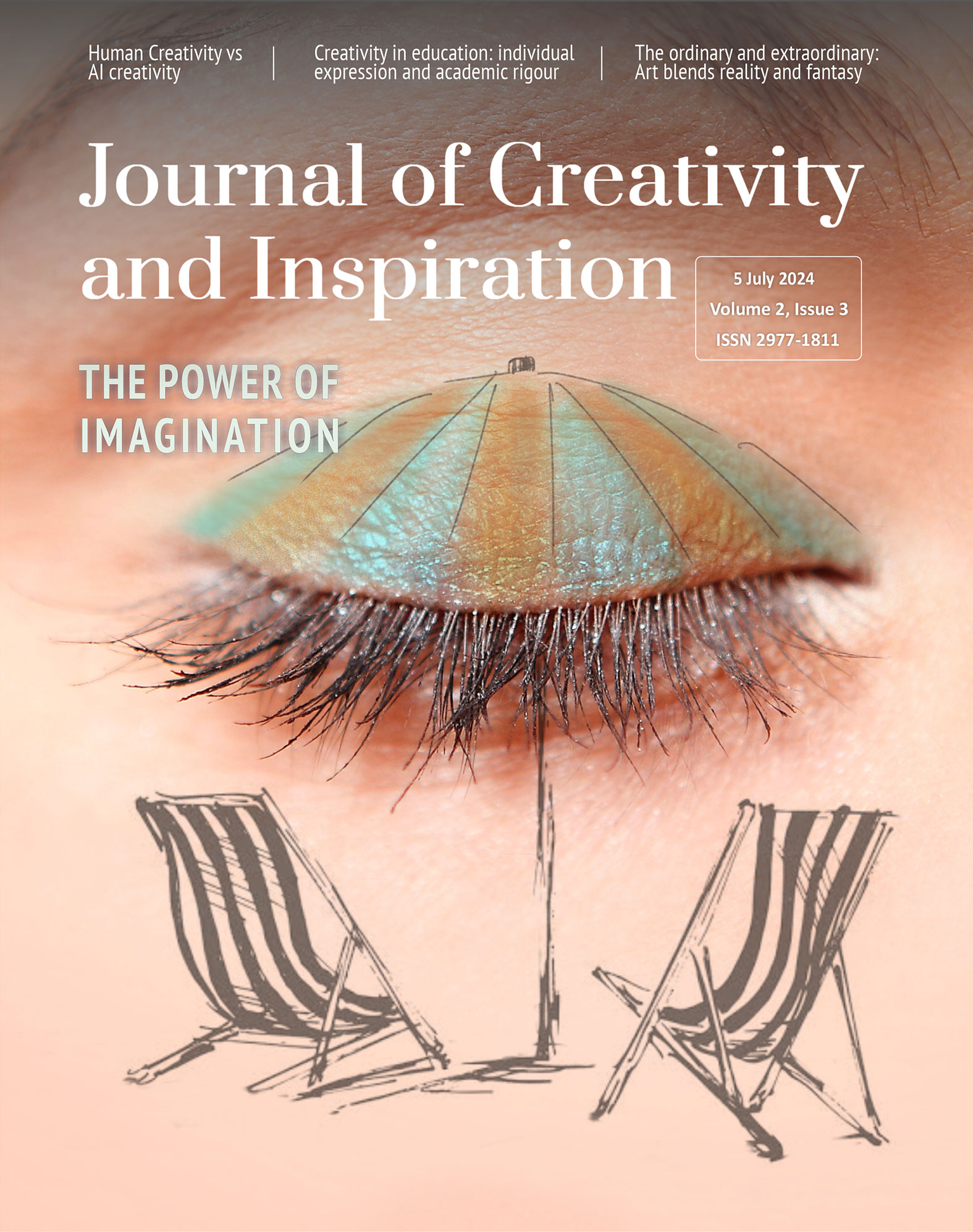The creative process of contraction and expansion
5 July 2024 – Vol 2, Issue 3.
The Universe operates on a rhythm, a pattern. This pattern often involves a cycle of contraction and expansion: the day and night, the tide coming in and out, the seasons coming and going. Likewise, your heart contracts and expands, your mind contracts and expands; everything is pulsing in and out. In this article, we argue that this pulse is forming the structure of creative processes in life, and that if we align with it, we can learn to become more creative in our actions.

‘The Pulse’, by AI / Gil Dekel. 2024.
When a caterpillar is coming out with a new body, it is not yet aware of the new body. It only knows that it needs to shed the old. The shedding process starts with removing, contracting, and narrowing down. The narrowness is a space where you have to let go of the previous in order to expand into the new. Then, the process of expansion begins, with the new body.
Becoming more creative in life requires shedding old patterns. The starting point is to look around, inquire, and recognize when a state of contraction commences. There are internal and external signs that can tell you if a state of contraction has begun. Some signs come from within us on an individual level, and other signs come from society around us. Indeed, artist Kandinsky explains (1979: 21) that the ideal way to inquire is to investigate each individual phenomenon in isolation, and then explore the effects of collective phenomena on the individual.
One internal sign is a growing feeling of a need to change things in your life – to clean up, declutter, to expand, to free up space. You may want to cut relationships that are falling apart, and that do not have strong foundations. It may be painful but necessary if relationships no longer align with your path. This is perfectly ok, as people need to walk their own path. You don’t want to hold them back from their journey.
Each person is like a voice within music. The voice comes at the right time, at the right pitch, and at the right frequency. And then it goes. Would we ask ‘What happened to c-major?’ No, we would not. We simply know that every note comes and goes at the right moment. There is a process of expansion and contraction in music, and it creates something new even though some notes may not appear again in the same frequency. In the same way, you can align yourself with new ‘notes’; with new people, places, a new job, or new interests. Similarly, when artists write, draw or paint, they start with one dot, or one stain. Yet, no line is the same, no intensity is the same. The thickness, the tone of colour change along with our feelings and thoughts. It is alive, and pulsing.
There are also external signs to observe. Notice if there is an increase in the illusions and fears that people generate for one another; an increase in the ‘smoke and mirrors’. To recognize what is true and what is not, listen to what your heart tells you. There is no need to listen to mass-produced media, because anything that is produced for the masses has the danger of promoting obfuscation.
You cannot control what humanity at large has manifested. Some of the shadows arising are not of your dealings. Some of it is other people’s fears and manifestations. But the way you react to that makes the difference. Your choice from the heart will make a difference. To get to the truth – to the centre of the maze – step away from any mass-produced products, be it information or objects, and instead go back into yourself. Feel with your heart. Try closing everything off, and think, ‘Is it relevant to me now?’ No. ‘Do I feel the need to go with it?’ No. ‘Does it speak to me?’ No… In which case, it’s not for you. Listen to the trees, they would know… Listen to the birds, to the moon… The pulse is about creation, not death.
You can follow simple practices like art. Make art or speak to artists. Artists hear the voice of the spirit, and follow that voice (Kandinsky 1972 [1912]: 29). Since creativity takes place in all areas of life (Pope, 2005: 4) you can also practice mindful breathing or connect with nature – walking barefoot on the earth, hugging trees, or simply spending time outdoors. William Blake, according to Bowra (1976: 13), explains that nature is a symbol of spiritual knowledge. Carl Jung adds (1972: 23) that nature is connected to our minds. Nature and arts will help you remain centred.

‘Plant the Future’, by AI / Gil Dekel. 2024.
When you are centred, you can notice the phase of contraction and the illusions around you. You can then progress to the phase of expansion. Expansion requires a thought, a decision that will define where/what we want to expand into. What new narrative do you wish to explore. What story do you want to weave now for you to experience. Think about what you would like to manifest next. You don’t have to manifest immediately. You may not know how. You may not even be sure of what you want to dream into existence. What you do know is what sets your heart with joy, on fire, with light. What brings peace into every cell of your being. You knew it from the moment you were born… You knew it when you were little. Yet, every time you push it away, you invite a contraction.
Start with writing your goals as a list of ideas. Words, Koestler explains (1964: 173), help crystallize vague concepts and make them precise and articulated. Yet, creativity often starts where language ‘ends’ (Koestler, 1964: 177). So, after you write a list, try to converse with your imagination. Imagination helps see things that the intelligence is blind to (Maurice, 1976: 7). Start to see your goal, dream it, visualize it. Maybe make a dream page cut out from magazines, or a vision board. It doesn’t have to be big. Visualisation is basically a story in pictures. It is an unfolding imaginary experience. Just as you go into any creative flow – be it healing, art, dance, music or cooking – you don’t plan as such. You go, you start, you feel it.
By focusing on what truly excites and inspires us, we set powerful creative forces into motion. As we align our thoughts and emotions with our visions, we focus attention on actions – we attract the necessary resources and opportunities to bring them to fruition.
At a glance:

Our thanks to Guan Yin, a spiritual essence which ‘came’ to us in a guided meditation, and which inspired insights for this article.
© Journal of Creativity and Inspiration.
Images © Gil Dekel.
Natalie Dekel, MPhil, B.Ed, BA, is a fully certified hypnotherapist (dip HSOH), Reiki Master/Teacher, Yoga Teacher and visionary artist. She has been offering healing and guidance since 2007. Natalie is the co-author of the ‘Energy Book’.
Gil Dekel is a doctor in Art, Design and Media, specializing in processes of creativity and inspiration. He is a University lecturer, visionary artist, Reiki Master/Teacher, and co-author of the ‘Energy Book’. He was awarded the Queen Elizabeth II Platinum Jubilee Coin, in recognition of his dedication and commitment to pastoral work at Hampshire Constabulary.
References
Bowra, M. (1976) The Romantic Imagination. Oxford: Oxford University Press.
Jung, C. (1972) “Approaching the unconscious”. In Jung, C. (ed.) Man and his Symbols. London: Aldus Books.
Kandinsky, W. (1972) Concerning the spiritual in art: and painting in particular [1912]. New York: George Wittenborn, Inc.
Kandinsky, W. (1979) Point And Line To Plane. New York: Dover Publications.
Koestler, A. (1964) The act of creation. London: Hutchinson.
Pope, R. (2005) Creativity: Theory, History, Practice. London: Routledge.
